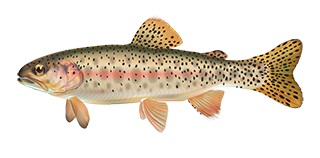
The Fish Sustainability Index (FSI) combines scientific and local knowledge to assess the health of Athabasca Rainbow Trout in Alberta.
Athabasca Rainbow Trout FSI maps
Adult density (current and historic)
- Current Adult Density Fish Sustainability (FSI) Rankings for Athabasca Rainbow Trout
- Historic Adult Density Fish Sustainability (FSI) Rankings for Athabasca Rainbow Trout
Please note that data reliability is not currently displayed in these figures.
Habitat and overharvest protection needs
- Habitat Protection Needs Fish Sustainability (FSI) Rankings for Athabasca Rainbow Trout
- Overharvest Protection Needs Fish Sustainability (FSI) rankings for Athabasca Rainbow Trout
Please note that data reliability is not currently displayed in these figures.
The complete FSI spatial data layers can be viewed and downloaded in:
Athabasca Rainbow Trout population status
Athabasca Rainbow Trout have shown severe declines from historical abundances and are ranked as threatened under the provincial Wildlife Act, and as endangered by the national Committee on the Status of Endangered Wildlife in Canada (COSEWIC). The 2017 Alberta Fish Sustainability Index (FSI) assessment confirmed these conservation designations, with all Athabasca Rainbow Trout populations classified as high risk. Careful management, conservation-focusing angling practices, and integrated land use management practices in key watersheds will be important in conserving native Rainbow Trout.
Historically, of the 19 watersheds within their native Alberta range, Athabasca Rainbow Trout were moderately to very abundant in 11 watersheds. Several watersheds on the fringe of core Athabasca Rainbow Trout range held fish, but likely at lower densities as naturally warmer or colder waters were likely limiting.
As of 2017, all Athabasca Rainbow Trout watersheds were assessed as either low or very low abundance of adult fish. Healthy populations remain in isolated creeks but no longer exist within an entire watershed.
Threats to sustainability
The main threats to sustainability of Athabasca Rainbow Trout were noted as:
- Habitat: Heavy land use and development including forestry, oil and gas, agriculture, and urbanization are associated with poor Athabasca Rainbow Trout status. Changes to surface and groundwater flow, stream fragmentation, sedimentation and loss of riparian cover may be causes of declines and failures of recovery. The effects of these land-use activities may be exacerbated with climate change.
- Harvest: Sport fishing mortality, even with catch and release, when combined with other activities on the landscape might be enough to prevent recovery of the remaining vulnerable populations.
- Hybridization: Well-established non-native Rainbow Trout and Brook Trout populations can compromise Athabasca Rainbow Trout populations through competition and replacement.
Next steps
- Habitat: Ongoing habitat restoration work remains a focus, with activities such as removing fish barrier culverts and reducing and mitigating sediment sources and activities. The cooperation between government agencies, industries and stakeholders will continue to be important in order to make meaningful changes.
- Harvest: Recent increases in East Slopes angling pressure has the potential to prevent recovery of already vulnerable Athabasca Rainbow Trout populations. Although Rainbow Trout within their native range have been catch and release since 2012, the combination of low rates of catch and release mortality, many anglers and few fish may be enough limit recovery. Studies of potential management actions are being conducted which may include angling restrictions, season changes or sanctuaries.
- Hybridization: Genetic monitoring will continue to identify hybridized populations and direct restoration efforts. In the future, small-scale invasive fish removal programs may be considered.
- Successful Athabasca Rainbow Trout recovery will require considerable work and collaboration between government, Indigenous peoples, anglers, landowners, industry and other stakeholders. Long-term success of recovery actions will require identifying the root cause of declines, and implementing programs at a meaningful scale for recovery.